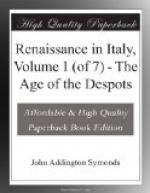[1] Compare, however, Varchi, quoted above, p. 243. The Report of Marco Foscari, Relazioni Venete, series ii, vol. i. p. 9 et seq., contains a remarkable estimate of the Florentine character. He attributes the timidity and weakness which he observes in the Florentines to their mercantile habits, and notices, precisely what Varchi here observes with admiration: ’li primi che governano lo stato vanno alle loro botteghe di seta, e gittati li lembi del mantello sopra le spalle, pongonsi alia caviglia e lavorano pubblicamente che ognuno li vede; ed i figliuoli loro stanno in bottega con li grembiuli dinanzi, e portano il sacco e le sporte alle maestre con la seta e fanno gli altri esercizi di bottega.’ A strong aristocratic prejudice transpires in every line. This report was written early in 1527. The events of the Siege must have surprised Marco Foscari. He notices among other things, as a source of weakness, the country villas which were all within a few months destroyed by their armies for the public good.
Their mode of life is simple and frugal, but wonderfully and incredibly clean and neat; and it may be said with truth that the artisans and handicraftsmen live at Florence even better than the citizens themselves: for whereas the former change from tavern to tavern, according as they find good wine, and only think of joyous living; the latter in their homes, with the frugality of merchants, who for the most part make but do not spend money, or with the moderation of orderly burghers, never exceed mediocrity. Nevertheless there are not wanting families, who keep a splendid table and live like nobles, such as the Antinori, the Bartolini, the Tornabuoni, the Pazzi, the Borgherini, the Gaddi, the Rucellai, and among the Salviati, Piero




